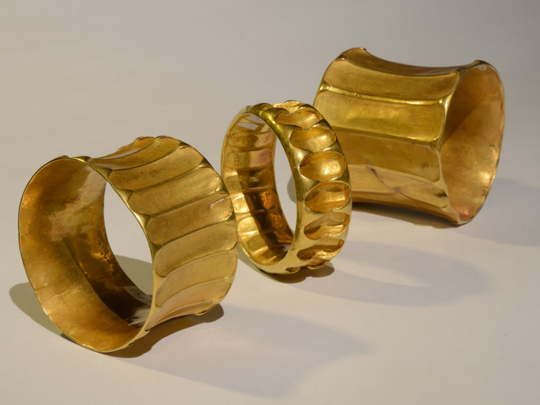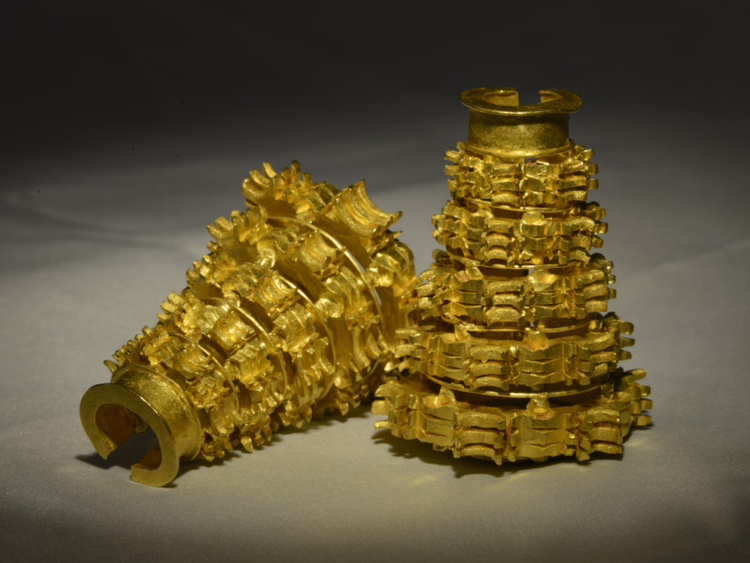
A unique exhibition of gold artefacts from the Philippines, dating back to the 10th to 13th century, has captured the imagination of the public in New York. Besides these unique artefacts from the precolonial history of the Philippines, this collection of gold ornaments, decorative items and other objects bearing a strong Hindu-Buddhist cultural influence also casts a different light on the history of the Philippines.
Not much is known about the history of the nation before the Spanish conquest led to the country being a colony for 400 years. Many scholars, researchers and historians now say that the collection promises to herald a “completely new understanding” of the Philippine’s history.
The exhibition, “Philippine Gold: Treasures of Forgotten Kingdoms”, opened in mid-September at the Asia Society in New York.
The Philippine Consul-General in New York, Mario de Leone, who was invited to a preview with the media, told Weekend Review that the exhibition was the biggest Philippine event of its kind to be held in New York. “This is the first time that these gold artefacts are shown outside the Philippines,” he said.
Some experts have gone to the extent of comparing the intricate gold work to the collection showcased in the exhibition of King Tutankhamun’s tomb and his treasures.
An exquisite piece is the “Kinnari” vessel from Surigao. Designed as half-woman and half-bird, it reflects the Indian mythical “kinnari”, a celestial female with wings and legs of a bird personifying beauty, grace and accomplishment.
Another masterpiece is a heavy gold caste cord that denotes the existence of a prosperous upper class with a strong Hindu cultural influence. And then there are lotus ear ornaments from Butuan, belt buckles from Mindanao and burial ensembles from Daet and elsewhere.
Florina Capistrano-Baker, who has a doctorate in the history of Asia-Pacific and in-depth knowledge of precolonial Filipino art, is a special consultant for international operations as well as consulting curator at the Ayala Museum in the Philippines. She told Weekend Review that “we ourselves were not aware of the Philippines’ Hindu past. As the gold artefacts here suggest, we had strong links with the Hindu culture in India or through Bali, Indonesia ... this culture was ubiquitous in the Philippines”.
Photography by Neal Oshima; courtesy Ayala Museum Kinnari vessel Surigao, 10th–13th century
She rues that the period before Spanish colonialism was de facto “erased from the Filipino consciousness”. She cited similarities between the customs, culture, architecture, etc. that were prevalent at that time in Southeast Asia.
Capistrano-Baker says that the discovery of these gold artefacts had uncovered evidence of a lost civilisation, which was “revolutionary”.
“The economic implications will also be immense. By highlighting and depicting this past, we can attract tourism from countries that will have an inherent interest in such artefacts,” she said, adding that it will appeal not only to Hindu and Buddhist tourists from India, Japan, Singapore, South Korea, Taiwan, Thailand, Malaysia and Indonesia, but also from the West.
She said she would also seek material and research help available from India and other countries that should be interested in this discovery.
Adriana Proser, an Asian arts specialist and senior curator at the Asia Society, said that the spectacular works in the exhibition — including exquisite regalia, jewellery, functional and ritualistic objects, ceremonial weapons and funerary masks — stemmed from collections in the Philippines and were supplemented with objects from the United States.
“This exhibition showcases recently excavated objects that highlight the prosperity and achievements of the little-known Philippine kingdoms that flourished long before the Spanish discovered the region and colonised it,” Proser told Weekend Review.
The collection, which comprises about 120 objects, also reflects sophisticated gold-work techniques developed during this period. Most of the works in the exhibition are on loan from the Ayala Museum and the Bangko Sentral ng Pilipinas Gold Collection.
Many of the works, excavated between the 1960s and 1981, affirm the unprecedented creativity, prosperity and sophisticated metalworking tradition of the precolonial period. They also bear testimony to the flourishing cultural connections and maritime trade in Southeast Asia during what was an Asian economic boom.
Experts now want to find out the reasons behind the Spanish attempts to hide or even obliterate the Philippines’s precolonial history. Would it be an oversimplification to say they wanted to “Christianise” the country?
Filipino experts told this writer that in addition to the array of gold objects from various sites throughout the archipelago, archaeologists had recovered hundreds of clay crucibles for smelting gold, gold-working tools, and raw and wrought gold during the excavations of precolonial wooden plank boats (balangay) in Butuan in 1976.
In precolonial Philippine politics, village chiefs, called “datu”, ruled through consensus. Some of the objects showcased in the section Adornments for the Datu contain remains of the adornments, weapons and garments that marked the prosperity and power of the datu, whose similarity with the present-day Malaysian title “Datuk” or “Dato” (knighthood granted to Malaysians) is quite striking, though it is premature to claim historical etymological links between the terms.
An affluent datu who actively engaged in foreign trade assumed the loftier Hindu title “rajah”.
The exhibition is divided into four sections: archaeology, trade, the Kingdom of Butuan and the surrounding kingdoms.
Most objects trace back to the Kingdom of Butuan — a still scarcely understood civilisation centred on the island of Mindanao that rose to prominence in the 10th century before mysteriously declining in the 13th. But it took more than seven centuries for the objects to be found, and even after their discovery, they were not seen in the West for several decades.
Like in India and China, gold played an important role in the history of the Philippines, a country that, some geologists say, may have huge gold deposits.
According to Filipino experts present at the exhibition, many artefacts were dug out in the 1970s during the construction of a network of drainage canals. Among them were ceramics of Southeast Asian and Chinese origin, as well as boats used in trading. These details have been supported by records from China’s Song Dynasty, whose officials maintained contact with Butuan in the early 11th century. There is evidence to suggest that an enterprising and wealthy seafaring civilisation existed in the Philippines centuries before Spanish colonisation began with explorer Ferdinand Magellan’s arrival in 1521.
The discovery of these gold artefacts reads almost like a thriller. A construction site in Mindanao in southern Philippines in 1981 turned up what would be the most valuable Butuan cache. It was by sheer accident that Berto Morales, who was using heavy digging machinery, discovered a gold bowl. He dug further and discovered gold bracelets, vessels, necklaces and other ornaments. By the end of the day he had piled up a tidy collection of artefacts.
But Morales, unaware of the true value of his find, took the artefacts home and hid them for a while before approaching his parish priest to find out how he could benefit from the discovery — a decision he would later regret.
As word spread, gold hunters and other dubious characters thronged the site. And allegedly, even the military, on the pretext of protecting the finding, moved to the site to get “a fistful of gold”, as Filipinos like to say.
Meanwhile, Morales found his own life and that of his family in danger. His family was kidnapped and released when he paid ransom. He then fled the island and lived under a new name. But when he returned, the priest told him that the remaining items were not there any longer.
Luckily, some of the artefacts landed at the Central Bank whose governor Jaime Laya, an art collector, recognised the value of the objects. Many of the artefacts were also bought by Leandro and Cecilia Locsin, who prevented the objects from being melted and sold in the market — a fate that many other objects had faced.
Cecilia Locsin, an archaeologist, spared no effort to preserve the artefacts. In 2008, the Butuan gold artefacts were displayed at the Ayala Museum, protected by a special security force.
The exhibition has aroused interest in the Butuan Kingdom. As Capistrano-Baker put it, she would like the world to help unearth the “rich culture and history of the Philippines”.
Manik Mehta is a commentator on Asian affairs.
“Philippine Gold: Treasures of Forgotten Kingdoms” will run at the Asia Society, New York, until January 3, 2016.











